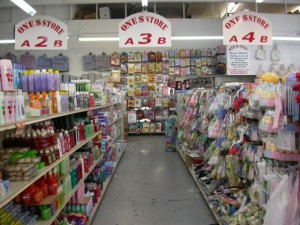by admin | Apr 14, 2021 | Apparel, Consumer, Retail, The Bottom Line
After the horrible fire in Bangladesh in November that killed 112 people, it came out that some major retailers were using the factory to source clothing.
Obviously, this is a really tragic event and a lot has to be done to improve working conditions and safety in factories like this.
 But I can’t help thinking that some of the blame for this type of thing falls back to not only American companies – but also American consumers.
But I can’t help thinking that some of the blame for this type of thing falls back to not only American companies – but also American consumers.
Let’s face it…We want to buy things cheaply. That’s why Walmart is so popular and that’s why so many of us shop there.
But Walmart itself is under constant pressure and faces competition from other retailers to continually lower prices to entice consumers.
And this keeps driving them (and companies like them – I’m not just singling out Walmart here) to keep cutting prices.
Cutting prices, while great for consumers, has an effect. It ripples through the supply chain of a big company.
And eventually…corners get cut.
Somewhere along the line the constant pressure to get things cheaper causes manufacturers, suppliers and retailers to cut costs in a variety of ways.
Maybe they find more efficiences in their supply chain.
Maybe they cut the quality of their products.
Maybe they cut the selection they offer.
Maybe they cut manufacturing costs with technology or other innovations.
Maybe they use the cheapest factories they can find that still produce the same goods.
Maybe certain safety standards get relaxed or overlooked.
These cuts do not always have tragic consequences. I am not saying there is an immediate link between cost cutting and safety.
Some of this pressure is good. It causes companies to innovate and lets other companies compete if they can do things better, faster and cheaper.
But how much are we willing to sacrifice for cheap goods?
Are there other ways to cut costs and lower prices for consumers?
This is a bit of a riddle because I don’t think the downward pressure on prices is going away any time soon. We all want the most for our buck.
I don’t know the answer, but I’m curious to hear your thoughts.
Drop me a line at ryan@dva.com.
by admin | Apr 14, 2021 | Dollar Chains, Retail
 Depending on what part of the country you live in and your shopping habits, you may be familiar with “Dollar” retailers.
Depending on what part of the country you live in and your shopping habits, you may be familiar with “Dollar” retailers.
These chains – like Dollar General, Family Dollar, Dollar Tree and others – have been growing rapidly in the last decade.
Just as one example, there are over 10,000 Dollar General retail stores in the U.S. As a comparison, there are about 1,700 Target stores in the U.S.
However, news recently came out that these stores are struggling. Their stock prices are all down.
Have Dollar stores peaked? Are they good for consumers?
It’s an interesting question.
In general, the Dollar stores set themselves up as an alternative to big-box retailers like Walmart and Target. Dollar stores are smaller and, often, closer to population centers. (As opposed to the suburban locations of many Walmarts, Targets, etc).
But, with the recession, it’s my suspicion that Dollar stores started becoming much more of shopping staple for people at lower income levels.
When things are tight, you buy just what you need. Dollar stores specialize in smaller sizes at lower price points.
You don’t “stock up” with the large sizes available at Walmart, Target or Costco.
Also, a trip to one of the bigger retailers means a drive – which means gas. Depending on where you live, if it’s a 50-mile round trip drive to Walmart, that can add up when gas prices are high.
So, and this is only a theory, one possible reason for the downturn at Dollar stores is that the economy is actually doing better.
Maybe people are actually making the trip to bigger retailers instead of shopping at Dollar stores.
This is just one possibility. Of course, there were other things going on in the retail landscape last quarter – notably Hurricane Sandy – that affected results.
Dollar stores do provide a valuable retail outlet in many communities. I don’t think they’re going away.
When you just need some milk or toilet paper, it’s much easier to make a quick stop at a Dollar store than travel all the way out to the Walmart.
For those of us that live in urban areas, we have to remember that when you live in a rural area, shopping patterns are much different.
For me, I can get to a big retailer in about 10 or 15 minutes. The discrepancy between a quick trip to the Dollar store and a long trip to the big-box retailer is not the same for me
So what’s the future for the Dollar chains? Many of the chains still have plans for expansion.
Is this a smart move? Have they maxed out and made too many stores (a la Starbucks a few years ago)?
As the economy improves, will the Dollar stores continue to grow?
Tell me what you think. Drop me a line at ryan@dva.com.
by admin | Apr 14, 2021 | Home Entertainment, Retail
 Pretty much everyone who follows the entertainment industry knows that DVD sales are declining.
Pretty much everyone who follows the entertainment industry knows that DVD sales are declining.
The “death of the DVD” has been happening for at least eight to 10 years now.
But I’d just like to point out a few things that make the stories about the decline of the DVD just a little more complicated.
First of all…though sales have gone down. Hollywood studios still make a lot of money on DVD and Blu-ray sales.
Home video sales in 2011 were about $18 billion dollars. That’s right. Billion.
Now, of course, that is down from about $22 billion (the peak of sales) in 2004.
No one in business wants to be losing sales. But anything that you’re still making billions of dollars on is still a viable business – at least for a while.
Just as a comparison, the online video business (which includes Netflix, Apple’s iTunes and other services) did about $992 million in sales in 2011.
But the writing is on the wall. DVD sales are going down and streaming sales are going up.
Even Walmart is getting into the game by adding a streaming service (VUDU) to Walmart.com.
But streaming is not the only thing cutting into DVD sales – let’s not forget things like Facebook, video games, Angry Birds, Twitter…and on and on.
So you’ve got an interesting situation here: A giant business is on the decline. But just like the dinosaurs, it won’t go quietly.
The introduction of the Blu-ray format seemed to help DVD sales stabilize a bit. But, in my opinion, the vast majority of the public is not that concerned with the nuances of the resolution of their movies. The leap from VHS to DVD was so huge that everyone noticed. But the improvement Blu-ray makes over DVD just is not that big to the average consumer.
But…on the other hand, let’s face it, it’s still a little bit of hassle to get pure streaming on your TV. The easiest way to do it is to use your cable provider (like Time Warner) to order up movies. Using Amazon or Netflix still requires one extra step (like a Roku box or Blu-ray player or game console) or a more-expensive smart TV.
My point is that it’s not quite “plug and play” which is what most technology requires for wide adoption.
It’ll be an interesting next few years to watch. The studios have already been finding alternative ways to maximize their profits with streaming services.
And until the streaming services produce their own content, the studios will still have some leverage.
So stay tuned…and, as always, call me or drop me a line (ryan@dva.com) if you have any thoughts on this.
 But I can’t help thinking that some of the blame for this type of thing falls back to not only American companies – but also American consumers.
But I can’t help thinking that some of the blame for this type of thing falls back to not only American companies – but also American consumers.


Recent Comments